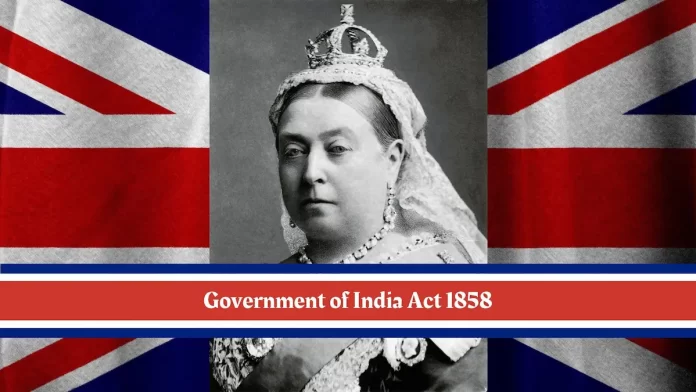On August 2, 1858, the British Parliament passed the Government of India Act 1858. The British government presented it as an act for the better government of India.
The Act abolished the Company rule in India and proclaimed Queen Victoria as the Empress of British India. Further, it appointed a member of the British cabinet as the Secretary of State for India.
The Government of India Act 1858 assumes great significance as it was enacted in response to the great revolt of 1857, also known as the First War of Indian Independence.
Features of the Government of India Act 1858
Important features of the Government of India Act 1858 include the following-
Abolition of the East India Company Rule in India
The Government of India Act 1858 brought an end to the Company rule by transferring all powers of government, territories, and revenues to the British Crown.
It declared Queen Victoria as the sovereign of British India. It provided that India henceforth was to be governed by, and in the name of, Her Majesty.
To this end, the then Governor-General Lord Canning organized a grand Durbar at the former provisional Mughal capital Allahabad where he publicly read the “Queen’s Proclamation” issued on November 1, 1858.
Thus, the government of India Act 1858, effectively brought an end to the East India Company’s rule in India. And the British assumed direct responsibility for the administration of India.
From Governor General to Viceroy of India
The Act changed the designation of the Governor-General of India to that of Viceroy of India.
As opposed to the Governor-General, Viceroy was to be the direct representative of the British Crown in India.
Lord Canning who happened to be the last Governor-General also became the first Viceroy of India.
Secretary of State for India
In addition to Viceroy, the 1858 Act also created a new office, the Secretary of State for India.
The secretary of state was to be a member of the British cabinet and was responsible ultimately to the British Parliament.
He was to reside in London and was vested with complete authority and control over the Indian administration.
Council of India
The 1858 Act also established a 15-member Council of India to assist the secretary of state for India.
However, this council was only an advisory body. The secretary of state became the chairman of the council.
Most importantly, it constituted the secretary of state-in-council as a body corporate, capable of suing and being sued in India and in England.
Abolition of Dyarchy
The Government of India Act 1858 the Board of Control and Court of Directors thus ending the dual system of government established by the Pitts India Act 1784.
Some decades later, however, the Government of India Act 1919 reintroduced dyarchy at the provincial level.
Criticism of Government of India Act 1858
One major criticism of the Government of India Act 1858 is that it made no substantial and significant changes in the system of government that prevailed in India.
It only made some tweaks to the administrative machinery of the Indian Government which was to be supervised and controlled in England.
Notwithstanding the above criticism, the 1858 Act, however, reaffirmed the system of open competition first introduced by the Charter Act 1833.
